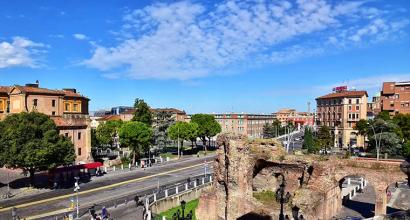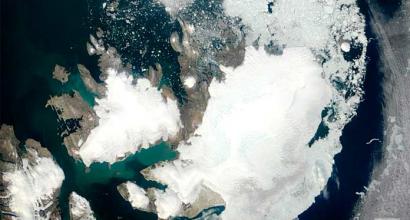Architectural, historical, natural monuments of the Crimean peninsula. Historical monuments of Crimea
The Crimean peninsula is one of the unique places on Earth. Sometimes it is called an “open-air museum” and this is well deserved. developed rapidly, succumbing to the influence of the peoples who lived in the Crimea at different times, from the Greeks to the Slavs and Tatars. The cultural monuments of Crimea are of great value. These include numerous objects that can be symbolically divided into several categories.
Archeological monuments
These are objects carrying information about the past that appear during excavations. From these finds one can trace how and began. In Crimea, traces of the Genoese (Genoese fortress in Sudak), Scythians (Scythian Naples), Greeks (Pantikapaeus, the site of Chersonesos) and other peoples living on the peninsula were discovered.
Monuments of religious significance
Representatives of different nationalities and religions live in Crimea. Shrines of different religions coexist peacefully here. For example, in Yevpatoria you can visit an Armenian church, a Jewish craft synagogue, the Juma-Jami mosque, several Orthodox cathedrals, and Tekie Dervishes (a monastery for nomadic monks).
Architectural monuments

There are different styles and trends in the architecture of Crimea. Quite famous architects worked here (Krasnov, Bernardazzi). Of particular interest are the well-preserved palaces with their garden and park areas (Vorontsovsky, Khansky, Livadia, Massandra). Separately, it is necessary to highlight the Swallow's Nest Palace, which is famous throughout the world and appears on numerous postcards, magazines, and guidebooks.
Monuments and art monuments
There are more than 300 museums on the peninsula. About 9 million people visit them annually. The variety of museums is amazing. By visiting them you can become witnesses of legendary events. In Feodosia there is a gallery of the famous artist Aivazovsky. There are monumental monuments throughout the peninsula.
These are not all cultural monuments of Crimea; the list can be endless. To this day, they arouse genuine interest not only among tourists, but also among archaeologists, travelers, and naturalists.
Related materials:

How to get to Kerch: options
There are many ways to get from Moscow to Kerch. The most convenient of them is air travel to Simferopol, and from there you can decide how to go to...

Apartments; Evpatoria - for family holidays
An apartment is simply a separate housing in which you will be provided with ready-made living conditions, right down to a washing machine. Isn't it true, compared to...

Representatives of the royal family of the Russian Empire were able to appreciate the beauty and healing nature of Crimea. The southern coast of the peninsula was chosen as the location for their summer residences, characterized by its excellent climate, picturesque nature and proximity to the sea. Such residences are the Massandra Palace and the Livadia Palace. The famous Yalta architect Nikolai Petrovich Krasnov was entrusted with developing the design of the royal palace in Livadia. He was also assigned to lead [...]
In the area of the Western coast of the Crimean peninsula, not far from the Evpatoria-Saki highway, near the village of Pribrezhnoye, on the Kara-Tobe hill, archaeological excavations are being carried out on the site of an ancient Greco-Scythian settlement. The name Kara-Tobe translated from the Turkic language is Black Hill (“kara” means black, “tobe” means hill, peak), and it was given to this settlement. In it in the 4th century. before [...]
The resort village of Alupka is located on the southern coast of Crimea, a few kilometers from Yalta. Tourists are attracted here by the famous palace of Count Vorontsov and the picturesque park laid out around it. In the center of the village stands the Church of St. Michael the Archangel with a very interesting history. The need for a Christian church arose in Alupka at the end of the 19th century, after the village expanded [...]
Crimea is a real Mecca for tourists. And they are attracted here not only by the picturesque nature, the sea and the rocky mountains. The peninsula is home to a huge number of historical and cultural attractions. The monuments of Crimea are cave monasteries, ancient cities, magnificent palaces and military monuments. Every year they are visited by thousands of travelers from different countries and continents.
We will tell you about the most interesting architectural, cultural and Crimea in our article.
Crimea and its treasures
The Crimean land is unique in many aspects. Geographically, it is a peninsula (practically an island), connected to the European mainland only by a narrow isthmus. It is washed by the waters of two seas - the Black and Azov. The northern and central parts of the peninsula are dominated by steppes and semi-deserts, and in the southern part the Crimean Mountains rise smoothly to end abruptly towards the sea with a grandiose rocky ledge.
Historically, Crimea is a conglomerate of many cultures and ethnic groups. Representatives of various nationalities live within its borders: Russians, Ukrainians, Crimean Tatars, Armenians, Greeks, Moldovans, Bulgarians, Gypsies, Jews, Turks and many others. Each of these ethnic groups brought their own architectural and cultural traditions with them to the peninsula. Their numerous traces can be seen today both in ancient Crimean buildings and in the everyday life of modern Crimeans.
Crimea is a real treasure chest. The entire territory of the peninsula is densely covered with these “treasures” - historical, cultural and architectural monuments. Crimea also gave the world a special school of painting - the Cimmerian. Representatives of this school were such talented artists as Ivan Aivazovsky, Adolf Fessler and
Top 20 historical and cultural monuments of Crimea
Crimea has absolutely everything a tourist needs: the sea, an ideal climate, mountains, forests, parks with exotic plants and, of course, a lot of historical and cultural sites. These are palace and park ensembles, medieval fortresses, remains of ancient cities, ruins of ancient buildings, cave monasteries, burial mounds, mysterious settlements and much, much more.
Below we list those monuments of Crimea that are of the greatest value and are most popular among tourists. So, here are these objects:
- "Chersonese Tauride".
- Panorama "Defense of Sevastopol".
- Monument to sunken ships.
- Adzhimushkay quarries.
- The royal mound in Kerch.
- Livadia Palace.
- Khan's Palace in Bakhchisarai.
- Aivazovsky Picture Gallery.
- Sudak fortress.
- Kafa Fortress.
- Eni-Kale fortress.
- Castle "Swallow's Nest".
- The ancient settlement of Kerkinitida.
- Cave city Chufut-Kale.
- Massandra Palace.
- Surb-Khach Monastery.
- St. Vladimir's Cathedral in Sevastopol.
- Victory Monument (Sevastopol).
Some of the listed Crimean monuments will be described in more detail later in the article. Among them are one historical, one architectural, one military and one art monument.
Vorontsov Palace and Park Ensemble
This outstanding monument of architectural and park art is located in Alupka on the Black Sea coast. It was created in the middle of the 19th century for Count M.S. Vorontsov with the participation of the best European architects and gardeners.

The palace itself is unique in its own way: its northern facade is made in the English Gothic style, and the southern one is decorated in an unimaginable combination! The hallmark of this ensemble is the southern main staircase, decorated with three pairs of white marble lions.
An integral part of Vorontsovsky in Alupka is a park with an area of 40 hectares. It contains an amazing botanical collection of exotic plants brought here from Asia, America and
"Chersonese Tauride"
The Tauride Chersonese Nature Reserve was created to preserve the unique ancient landscape on the southwestern coast of Crimea. In the fifth century BC, the ancient Greeks founded the city of Chersonesos near the modern city of Sevastopol. Thanks to its favorable geographical position, it very quickly turned into a powerful and prosperous city. In 2013, the ruins of Chersonesos received the status of a UNESCO monument.

The main square of the ancient city, the ancient theater (the only one in the CIS), the foundation of a medieval basilica, and the defensive tower of Zeno have survived to this day.
Aivazovsky Art Gallery
Art Gallery named after. I.K. Aivazovsky is located in Feodosia. This is one of the most important monuments of art in Crimea. The gallery presents paintings by different artists, which are united by one theme - marine. About 12 thousand paintings are collected here. 417 paintings belong to the brush of the famous marine painter I.K. Aivazovsky.
Ivan Aivazovsky is a Russian artist of Armenian origin. An outstanding painter and marine painter, whose paintings were admired all over the world. Born and raised in Feodosia, during his long and fruitful life he created over five thousand paintings. The main theme of most of his paintings is the sea.

Monument to the Scuttled Ships
Crimea has always been a tasty morsel for many empires and states. Therefore, almost the entire history of the peninsula is an endless chain of armed conflicts and wars. In the middle of the 19th century, another war broke out in Crimea. The monument, erected in 1905 in Sevastopol, is the most famous object dedicated to the events of those distant years.

The monument to sunken ships was erected in memory of those ships that had to be sunk in order to protect the city of Sevastopol from enemy naval attacks. This happened in 1855 during the so-called First Defense of Sevastopol in the Crimean War. A seven-meter column rises directly into the sea, topped with a bronze figurine of an eagle with a lowered head and open wings. The eagle's pose fully conveys the tragedy and hopelessness of this historical event.
The total height of the monument (including the pedestal) is 16 meters. The name of the author of this monument became known only in 1949. It turned out to be the outstanding Estonian sculptor Amandus Adamson.


